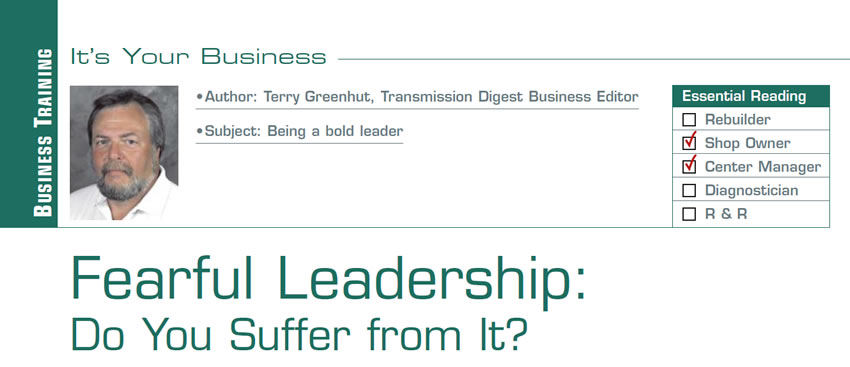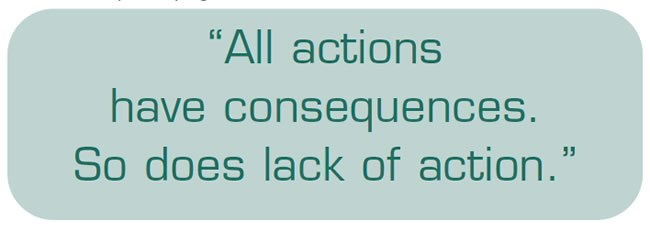
It’s Your Business
- Subject: Being a bold leader
- Essential Reading: Shop Owner, Center Manager
- Author: Terry Greenhut, Transmission Digest Business Editor
It’s a tough time to be a leader. What with the economy being so unforgiving, making smart business decisions is crucial. That’s true in terms of not only strategy (whether to change your service mix or move into a new marketplace) but also relationships (whether to fire the high-volume performer who drives you nuts or address the conflict head-on). All actions have consequences. So does lack of action. And with the margin for error so slim, you want to make sure you’re thinking as coolly and clearly as possible.

The key is to try not to let fear cloud your decision making. Although it’s true that we all feel fear, what separates good solid leaders from the mediocre is how they respond to that fear. Courageous leaders face what needs to be faced and do what needs to be done. Their opposites bury their heads in the sand, hope the problem will resolve itself or just make excuses for why they can’t perform.
Fearful leadership can keep us from taking the quick, decisive actions courageous leadership requires. It can actually have a crippling effect on an automotive business’s ability to grow or even maintain the status quo. Leadership from fear can have a detrimental effect on the people a leader should be guiding as well: the employees.
All leaders mess with people’s lives in many ways. They make decisions that affect others in both the short and long terms. That’s why it’s so important to make sure you’re leading from a place of clarity and awareness and not letting fear drive your decisions. Whether you’re messing with their lives in a positive, growth-inspiring way or a negative, spirit-crushing way depends on the clarity with which you make decisions and execute them. Fear obscures that clarity, especially fear that masquerades as something else. Many business owners and managers are unaware of how profoundly fear influences their decision making. You may be leading from a place of fear if the following apply to you:
You frequently take the easy way out. You avoid taking bold, decisive action because it makes you uncomfortable. Then, you rationalize why you didn’t do what you really needed to do. For example: The labor rate needs to be raised a few dollars an hour for the shop to be profitable, but the other shops in town aren’t that high so you don’t do it. Generally such rationalizations boil down to fear. What if you raised the rate and other shops didn’t? Would that give them an advantage? Would it give you a bad reputation? Would it scare all your customers away? The answer to all the above is “NO.” It would just allow you to be profitable while some of them won’t be, but it’s easier to avoid taking action (at least in the short term) – yet it’s also a sure path to mediocrity and stagnation if not failure.
You pretend you don’t know what you actually know. Pretending is common in business. You pretend you don’t know about opportunities in order to avoid risk. You pretend you don’t know that that high-performer employee is behaving badly and making co-workers unhappy. You pretend that your biggest customer isn’t crushing your morale by making demands of you that stress you to the limit and possibly isn’t allowing you to profit from doing business with him. Maybe you even pretend you don’t know it’s time for you to find a bunch of smaller accounts to service so that when this one big one finishes using you up and leaves, your business won’t be totally devastated.
All this pretending allows you to avoid pain and feel good in the short term, but it exacts a heavy price over time. There is always a price to be paid for needed actions not taken. Never doubt it. Your job as a leader is to look reality in the face and accept it so that you can make the tough decisions that need to be made.
You fall victim to “shiny ball” syndrome. Can you relate to this scenario? You’re trying to focus on a serious project when a “shiny ball” rolls by. It may be an email or a phone call or just a less-urgent task. You break away and chase the shiny ball until – well, would you look at that! It’s time to go home already!

Many of us can’t say no to such distractions. In fact, we don’t want to say no because what we should be focusing on is usually difficult, unpleasant or anxiety producing. Anyone can keep busy. It takes real courage to stay focused and on task.
You ignore what’s causing “weight and drag” in your company. You already know what this is, don’t you? Maybe it’s a policy, a person, or a scarcity or austerity mindset that’s holding you or your team back from optimal performance. Ask yourself now: “What am I doing, or not doing, that is adding weight and drag? Am I refusing to make a decision, waiting to hire an assistant, delaying a hiring or firing issue?”
The core of your job is your role as an obstacle remover. Be courageous: Remove the obstacles you can, and work around the ones that remain, so that your team can stay productive, directed and focused.
You refuse to balance your head and your gut. It takes both facts and intuition to analyze properly. Many leaders stick to the analysis style they’re most comfortable with. They make decisions strictly on the basis of either data or their gut instincts. The blend of both is what makes for successful decisions. Fear can make you shy away from making the gut decisions that are based on experience and lead you to go with only those supported by data – which might be only partially pertinent.
Courageous leaders, on the other hand, understand that decisions that have a direct impact on people’s lives require both aspects, and that means most of us need to step outside of our comfort zones when it’s time to make decisions. Your leadership will be enhanced, the performance of your team will improve and they will likely trust you more if you lead with both your head and your gut.
You hide behind the “I’m not quite ready” excuse. Leaders can spend too much time getting ready to be ready to get ready to almost get ready to be ready to get ready. Getting overly ready is a result of fear. You don’t want to fail so instead you put off the moment of truth by perpetually getting ready. Should you prepare? Of course! Do your research, but stop hiding behind the “we aren’t quite ready” curtain. Say, “Enough is enough,” and just do it even if conditions aren’t perfect, because they probably never will be.
If you want to build a culture in which people take action and aren’t afraid to boldly step out, then you had better be courageous enough to endure a lack of perfection and some chaos. A little messy and quick can be a lot better than perfect and slow in our rapidly changing business climate.
You forsake the present in favor of the future or the past. It takes courage to be fully in the present and discipline to not worry about what happened yesterday. Worry, anticipation, regret and hope are some of the mental processes that keep us from fully functioning as a good leader on a daily basis.
I am not suggesting that you should not plan for the future or ignore the past instead of learning from it. What I am suggesting is that all the planning and reflecting in the world provides no guarantees. If you decide to trade this moment for the memory of yesterday or the concern for tomorrow, you are likely to miss what’s happening now.

You see only the information that agrees with your beliefs. We all have a natural tendency to ignore information that contradicts our beliefs about the world. If we believe someone doesn’t like us, we will see only those behaviors that support that impression. If we think we are bad at something, we will see only more evidence of that conclusion. This tendency is so strong that it blinds us to contrary evidence. As long as we don’t see other possibilities we don’t have to take action.
You’re continually blaming others. This is an energy-draining, counterproductive way of dealing with difficult circumstances. Blaming someone else puts you in the position of victim, as if something happened outside your control. Therefore, you won’t take action to change your circumstances because it’s someone else’s fault.
Blame-based leadership seeks to find a bad guy so that there is someone to absorb the problem, as a lightning rod absorbs a bolt of otherwise dangerous electricity.
If a bad guy can be found, then everyone else can give a collective sigh of relief. For that particular problem, they are off the hook. Acknowledging that you are ultimately responsible for the results of your life, thoughts and actions creates a level of freedom not experienced by those who choose to blame others. It empowers you to act. Courageous leaders are driven by the need to eliminate excuse making and blame from themselves and their organizations.
You apply more pressure instead of looking for bottlenecks. Imagine that you are trying to drink from a water hose that has a kink in it. What do you do? Do you un-kink the hose, or do you run to the faucet and turn up the pressure? Obviously, you would do the former. Until you eliminate the kink – the bottleneck – all the pressure in the world won’t do a bit of good. Water will just begin to leak from the weak spots, and if the pressure isn’t relieved the hose will explode.
Now, think of this hose as an analogy for your company and the individuals who work in it. Consider a bottleneck as anything that slows, impedes or stops desirable results. It could be a process, a policy or procedure, a tradition, even a way of thinking. (Heck, maybe it’s you.) It is your job to seek out and eliminate these bottlenecks and, just as important, to free your people to openly and clearly identify them as well.
Too many leaders turn up the pressure in the hose when they need more output from their people. They push employees harder or offer new programs, initiatives and incentives to try to push them into compliance. Imagine how much more effective it would be to summon your courage and address the bottlenecks that need clearing.
Mental clutter is keeping you from moving forward. The more you fear, the more you try to do. The more you try to do, the more you have to think about. Once you can let go of some of the fear, you can turn down some of the activities and commitments. This will free up the time and space to do the things that inspire and invigorate you, that allow you to fully concentrate on the purpose at hand.
Without those moments of peace and clarity, you will keep on rushing until you burn out, never realizing that you could have stopped, adjusted and continued with less stress and greater success. Fear-centered leadership wreaks havoc with your entire life. The anxiety that comes from not doing what you know deep down needs to be done and from managing the fallout resulting from poor decisions drains the energy you could be spending on friends, family and the outside interests that make life worth living.

Terry Greenhut, Business Editor, Visit www.TerryGreenhut.com.













